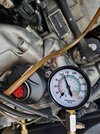lithium2g
Active Member
Speedster 1998 Rotax 787. Both original AFAIK.
Hey lads I havn't had my seadoo out for 6 months. There is no such thing as winter where I live just been busy. Engines fired up on the garden hose no problem. Took it out and no problems starting in the water. But after idling out and running low rpm for a minute, upon throttling i realized L side engine wasnt running at all. She wouldnt fire at this point. When cranking it gave some different noises, sounded like back firing. Im not really sure. It started intermittently on the trailer with some more noises sounding like backfire and would shut off.
So im thinking its dirty fuel in the carbs and we need to do a carb rebuild/clean. I've read mikeydac's guide several times in the last few years and i was about to buy the rebuild kits and the gear...i havn't taken the carbs off yet tho. IM prettty nervous attending to this task
Before i went down this path firstly I figured I'd test the engine compression just to rule out engine issues. I don't have the skill, will or the equipment to do engine rebuild here in Australia so I would be calling time on the girl if rebuild is required.
I bought a compression tester today. And watched a video of someone doing this on the tubes. On the dodgy L side engine im only getting 135PSI
So I try it on the good working R side engine both mag and pto is 135PSI also. Im thinking both engines are rooted?? Or my tester is bad. Or my testing method is bad.
When I had this boat professionally serviced 3 years ago they were all reportedly 160PSI.
I read about doing WOT (wide open throttle) when doing compression test, but I don't know what this means.
is that having the throttle maxed out when cranking the engine?
Any advice on how I should proceed?
I've installed/rebuilt/replaced drive shafts, jet pumps and reverse cable all thanks to this forum and its wisdom. Hopefully I can get through of this one.
Thanks

Hey lads I havn't had my seadoo out for 6 months. There is no such thing as winter where I live just been busy. Engines fired up on the garden hose no problem. Took it out and no problems starting in the water. But after idling out and running low rpm for a minute, upon throttling i realized L side engine wasnt running at all. She wouldnt fire at this point. When cranking it gave some different noises, sounded like back firing. Im not really sure. It started intermittently on the trailer with some more noises sounding like backfire and would shut off.
So im thinking its dirty fuel in the carbs and we need to do a carb rebuild/clean. I've read mikeydac's guide several times in the last few years and i was about to buy the rebuild kits and the gear...i havn't taken the carbs off yet tho. IM prettty nervous attending to this task
Before i went down this path firstly I figured I'd test the engine compression just to rule out engine issues. I don't have the skill, will or the equipment to do engine rebuild here in Australia so I would be calling time on the girl if rebuild is required.
I bought a compression tester today. And watched a video of someone doing this on the tubes. On the dodgy L side engine im only getting 135PSI
So I try it on the good working R side engine both mag and pto is 135PSI also. Im thinking both engines are rooted?? Or my tester is bad. Or my testing method is bad.
When I had this boat professionally serviced 3 years ago they were all reportedly 160PSI.
I read about doing WOT (wide open throttle) when doing compression test, but I don't know what this means.
is that having the throttle maxed out when cranking the engine?
Any advice on how I should proceed?
I've installed/rebuilt/replaced drive shafts, jet pumps and reverse cable all thanks to this forum and its wisdom. Hopefully I can get through of this one.
Thanks




